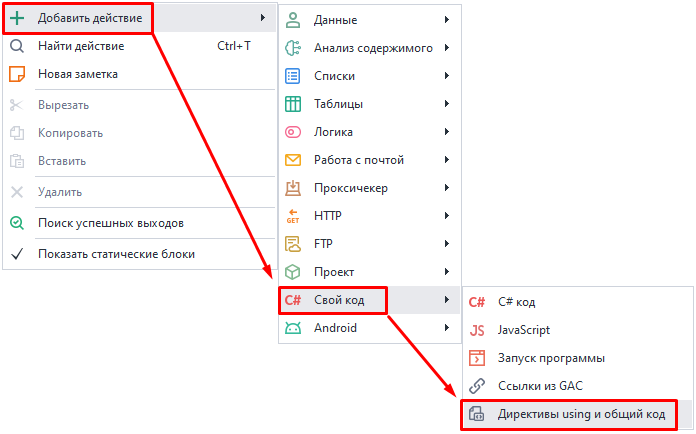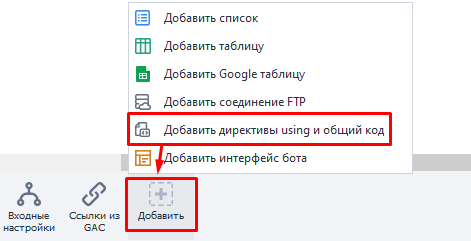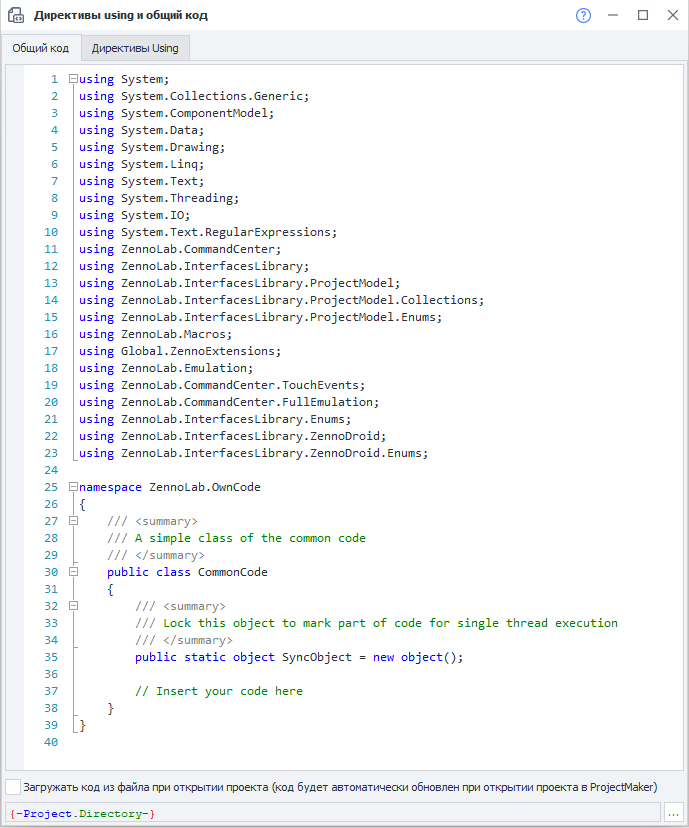Using Directives and Shared Code
Description.
Shared code is functionality that extends the capabilities of standard C# blocks. It's used to insert additional classes and functions.
And using directives are needed to access functions and classes, as well as to create namespaces.
How can you use this?
- Work with C# code more efficiently.
- Create new namespaces.
- Organize working with large amounts of code.
- Avoid naming conflicts.
How do you add it to a project?
Via the context menu: Add action → Custom code → Using directives and shared code.

Or through the Static block panel → Add → Add using directives and shared code:

Shared code.

This window is a code editor with syntax highlighting. In the context menu, you get access to basic code editing tools: copy, paste, comment, search, replace, etc.
At the bottom of the window, there’s a checkbox for loading code from your own file in .txt or .cs formats.
At the very top of the code are all the using directives used in your project. After that, there's an example of declaring namespace ZennoLab.OwnCode. You can create your own namespaces the same way and refer to them later.
To access functions and methods from the shared code, they need to be declared with the public modifier. If you don’t need to work with objects of a certain class, you can declare it static: public static. And if you aren’t planning to use inheritance, it’s best to declare the class as public sealed right away.
Using Directives.
When you open this tab, you’ll see two fields:
- Top field. This is for adding namespaces that are used when executing code in C# actions. For example, to parse XML you need to write
using System.Xml;. - Bottom field. Here you see all the using directives used by the project by default. You can’t edit these.
Example.
Let’s pass an image and a transparency coefficient to the SetImageOpacity method. As a result, you’ll get a semi-transparent picture you can save to disk.
public static Image SetImageOpacity(Image image, float opacity)
{
try {
Bitmap bmp = new Bitmap(image.Width, image.Height);
//create graphics from the image
using (Graphics gfx = Graphics.FromImage(bmp)) {
//create a color matrix object
ColorMatrix matrix = new ColorMatrix();
//set opacity
matrix.Matrix33 = opacity;
//create new attributes
ImageAttributes attributes = new ImageAttributes();
//set the image’s opacity color
attributes.SetColorMatrix(matrix, ColorMatrixFlag.Default, ColorAdjustType.Bitmap);
//draw the image
gfx.DrawImage(image, new Rectangle(0, 0, bmp.Width, bmp.Height), 0, 0, image.Width, image.Height, GraphicsUnit.Pixel, attributes);
}
return bmp;
}
catch (Exception ex) {
return null;
}
}
And here’s how you call this function from a C# action:
Image img = OwnCode.CommonCode.SetImageOpacity(Image.FromFile(project.Directory + "//image.jpg"), .5f);